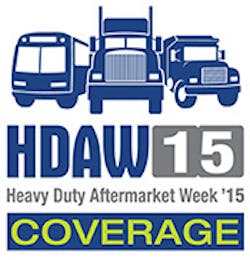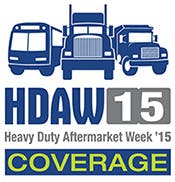Analytics expert says companies can increase profits by 300% by abandoning old accounting systems, getting more quality sales
RANDY MacLean believes that executives who shed the limiting beliefs that hamper growth can lead their companies to permanent profit levels that are double or triple the previous records within one year.
That’s right: 300%.
In his presentation, “Elevating Sales Systems Using Analytics & CRM (Customer Relationship Management),” MacLean, president of WayPoint Analytics, said his clients have seen growth of 300% or more.
Some other factoids:
• Less than 40% of customers in the typical distribution business are profitable.
• Less than 25% of invoices are profitable. “That means that 75% of the things you do lose money. That’s because the models invented by dad, granddad and great-granddad are not functional anymore. Companies that are not in our sectors are figuring this out and plotting this because they recognize where they make and lose money. And unless we can fight them off, they’re going to take a big chunk of the market away from us.”
• In wholesale business distribution, the nominal net before taxes (NBT) is 3% to 4% of sales. “Your models may vary depending on the industry. But in every industry, there are players in the second tier, and they make 10% to 13%. They make three to four times the profit of most companies.”
Some of the limiting beliefs that prevent people from being able to get this performance:
• Gross margin percentage. “They think it’s the best tool for profit management. It’s not. The reason we have gross margin percentage is because back when dad or granddad founded the business, they did everything on ledger sheets and everything was a percentage of revenue because that’s all we could calculate. When computers came around, we discovered gross margin so for the first time ever we had systems that would tell us gross margin. It was a much better tool because at least it took the cost of the product into account. Nowadays, we can go right to the bottom line.”
• Accounting system shows profit numbers. “Our accounting systems are supposed to show us profit, and to a certain extent they do. They will tell us how much money was brought in, how much money was spent on product, how much money was spent on everything else, and how much money was left over. That’s good enough for banks, the IRS, and us. But sometimes we have somebody smart in the accounting department and they start thinking, ‘How do we figure out if branches are profitable?’ They’ll get out a big spreadsheet and do calculations and say, ‘We need to move 14% out to Branch A and 21% to Branch B.’ But the accounting systems we have are only designed to show three things: how to manage inventory, how to manage receivables, and how to provide sufficient company-wide bottom line information to keep banks and the IRS at bay. And that’s all. Nobody ever gave any thought to what profitability would be in some of the other areas we need to look at in order to manage the business effectively.”
MacLean said he loves the term “gross profit dollars” because whether it comes from an account, product, or on a particular invoice, that is the operating budget.
“If I have $100 of gross profit on an invoice, I can’t spend more than $100 servicing that invoice or I’m under water,” he said. “Knowing that number is really valuable. The flip side of that is the cost to serve (CTS). It’s all of our operating costs that basically balance that out. How much did we spend on answering orders? How much did we spend on having, warehousing, packing, and shipping product? How much did we spend on delivering products to the customer? How much did we spend on overhead?”
He said whale curves are a great visual element that will help you understand where you’re making and losing money.
“Since we have profit numbers on every customer, we can use whale curves,” he said. “They start at zero. We take the most profitable customer and put it on there, then put profits for next most profitable, and third-most profitable, and keep working down. We end up with peak internal profit. That’s how much money made on all moneymaking business. Then we start adopting the small losses we took: 1, 2, 10, 100. By the time we get to the last sale, customer, and product, this shows us how much we have left. When I got into the business and I was trying to find out what was going on, we started to discover how massive the difference was between peak internal profit and the bottom line of your company.”
He showed a graph that illustrated how a particular small business had made $5.5 million on the best part of its business, but lost $1.2 million to dysfunctional business on the other end of the curve.
“Every one of you has a whale curve that looks like this,” he said. “Every one of you has a business that generates a lot more money than you know that it does or have seen because your accounting system doesn’t show it to you.”
How is money really made? Here are his truisms:
• The average is wrong in most cases. “Averages have a very specific purpose, and it’s never for forecasting. Averages are not good for looking at individual items that are coming along. You can’t use it to predict the next sale. Averages are very good if you are a 7-Eleven operator and trying to put a camera at the door to see where it should point. You can find out the average American male is 5-foot-10-inches tall and point it at that center line. But if you use it in Las Vegas to bet on the height of the next person to walk through the door, you’re going to be wrong most of the time. And that’s why it doesn’t work when you’re trying to predict an individual sale.”
• Gross margin percentage range versus cost to serve percentage range. “Gross margin percentages used to run between 15% and 35%. We all have a range of gross margins we operate in, and that is the top part of the sale we look at. The cost of sale can run anywhere between zero and 300% of the sale. And that happens every day. So if you just pick at random a gross margin out of the range and cost to serve, what is the possibility that you are going to wind up with a gross margin that is greater than the cost to serve? In 75% of the cases, it’s going to be upside down and you’re going to lose money.”
• Most sales add losses, not profits. “This is something that should make you crazy, something you need to help the organization understand. It’s not that the average sale is a good sale. Too much of our business is coming from a sales force that is being flogged to go and get another customer. And they’re bringing back the weak and the lame and the sick. And these are the guys that are getting farther away with slower and slower orders. The nature of sales is changing. It’s important not to get more sales, but to get more quality sales.”
• The accounting system is full of estimates and assumptions made some time ago. “There is such a thing as a journal entry, and the dirty secret of the family is that the journal entry is a way to force the system to do something it doesn’t want to do because you don’t have the right numbers to get it there. So the more journal entries you have, the more processes you have that run on journal entries, the bigger indicator you have that the system is not reflecting the business accurately.”
MacLean said he’s spent most of his life in sales. He says he understands it, but doesn’t love it.
“If anybody wants to hire a great sales guy with absolute sales skills that worked in 1985, I’m your guy,” he said. “But in 2015, I’m going to have a rugged road. The traditional role of the sales rep was prospecting, developing relationships, being an information vector, solving problems, making collections. We all remember this. We all did it.
“Some people think field sales are coming to a rapid end. I don’t think it’s as dire as that. But I think field sales will become a specialty as we see other things come in.”
The risk factors with sales:
• The company doesn’t own the relationship. “One of the biggest problems we run into when people are trying to get change made is the sales force would rather stay the way it is, and the CEO hasn’t seen a customer for a long time and is afraid that the sales guys are going to leave and take customers. If your major customers are guys who represent the top half of your profits—the guys the senior executives haven’t seen in a long time—there are serious problems.”
• Aging sales force. “According to a study in the gas and well business, the average sales person is 58. That’s crazy.”
• Millennial generation. “The problem is, by 2020 the millennials will have reached into middle management. And people that would rather order using a heretofore-unheard-of technology are going to be calling the shots. If you are a 60- to 65-year-old sales person, what are the chances you are going to be able to connect? This is a serious problem we need to address.”
• Customers are adopting electronic data interchange (EDI) and other technology. “The tech companies that are coming in are recognizing this and providing a communication mechanism with customers that’s going to be very important five years from now and might be the core of your business five years from now.”
He said that to use CRM:
• You need to have real profit numbers for customers. “If you don’t know who you’re making or losing money on, you’re sunk. Gross margin is not going to do the job.”
• You need good market information on potentials. “There are some great organizations to help assess businesses in your market. I’ll give you a clue: zip codes are going to do it. Somebody that buys efficiently is organized and somebody looking for the lowest price is likely the guy you want to trade off to the other side.”
• Segment by value. “Look at a customer by their profit value rather than their size.”
• Triage resource usage. “You only have so many people with so many hours in a day. The key is to make sure they’re working on the right things. The difference between somebody good and really, really good is not that they have a 160 IQ, but they dedicate their day to the vision thing, not get wrapped up in the tyranny of day to day.”
• Protect core accounts. “Identify them, service them to death, make a special sales organization for them so they have high fill rates, zero errors, low defects, and fast problem resolution.”
• Fix service drain account. “The ones in the red in the lower right-hand corner. There’s enough volume to make it viable. But transaction costs are sinking the ship.”
• Develop specialized service model pricing for marginal accounts. “When somebody’s showing up at the counter, are we going to give them contract pricing? No. Are we going to give them free delivery? No.” ♦
About the Author
Rick Weber
Associate Editor
Rick Weber has been an associate editor for Trailer/Body Builders since February 2000. A national award-winning sportswriter, he covered the Miami Dolphins for the Fort Myers News-Press following service with publications in California and Australia. He is a graduate of Penn State University.


